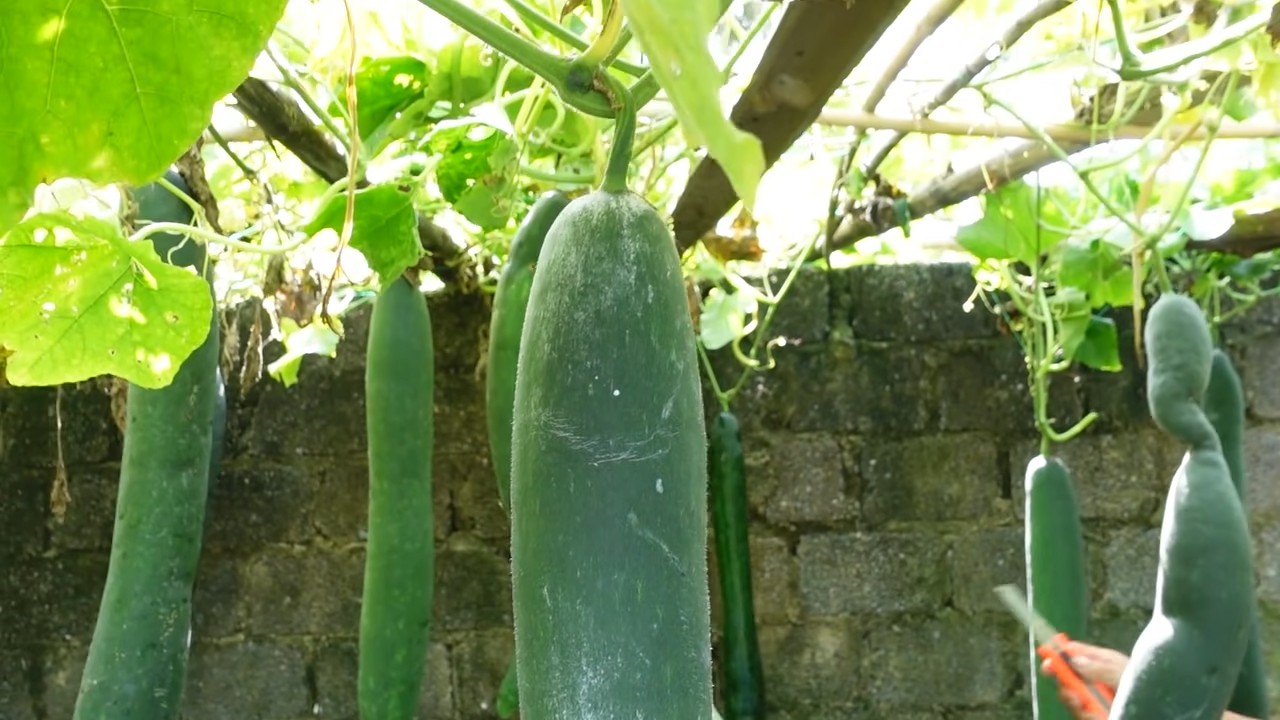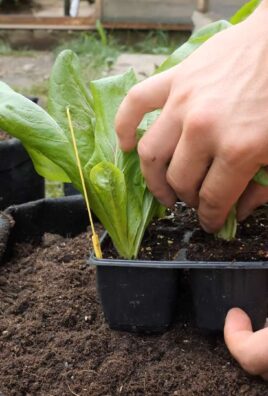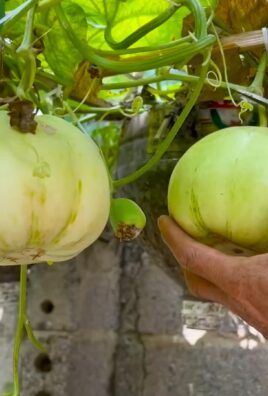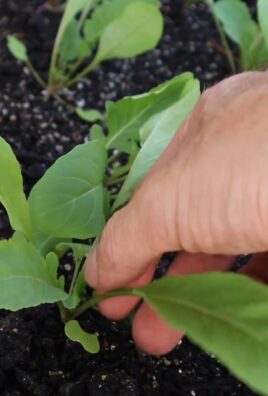Grow Zucchini at Home and unlock a world of fresh, delicious possibilities right in your backyard! Have you ever dreamed of harvesting your own vibrant, versatile zucchini, ready to be transformed into everything from savory fritters to decadent chocolate bread? Well, dream no more! This DIY guide is packed with simple, effective tricks and hacks that will empower even the most novice gardener to cultivate a thriving zucchini patch.
Zucchini, a member of the squash family, has a rich history, tracing back to Central and South America thousands of years ago. While its modern form is relatively recent, developed in Italy in the 19th century, its culinary versatility quickly made it a global favorite. From Mediterranean stews to Asian stir-fries, zucchini has seamlessly integrated into diverse cuisines.
But why should you bother to grow zucchini at home? Beyond the sheer joy of nurturing life and connecting with nature, growing your own zucchini offers unparalleled freshness and flavor. Store-bought zucchini simply can’t compare to the crisp, vibrant taste of a freshly picked homegrown vegetable. Plus, you’ll have complete control over the growing process, ensuring your zucchini is free from harmful pesticides and chemicals. In this article, I’ll share my favorite DIY tricks to help you avoid common pitfalls, maximize your yield, and enjoy a bountiful harvest of this summer squash. Let’s get growing!

Growing Zucchini: Your DIY Guide for a Bountiful Harvest
Hey garden friends! I love zucchini. They are so versatile in the kitchen and super easy to grow, even if you don’t have a huge garden. In this guide, I’ll show you how you can grow your own zucchini at home – from sowing to harvest. Let’s get started!
What you need:
- Zucchini seeds (preferably organic quality)
- Seedling pots or small containers
- Seed starting mix
- Larger pots (at least 30 liters in volume) or a bed in the garden
- Garden soil or compost
- Watering can or hose
- Mulch (straw, wood chips, or grass clippings)
- Plant stakes (optional, for vining varieties)
- Pruning shears or knife
Preparation is Everything: Sowing
Zucchini are sensitive to frost, so it’s important not to start sowing too early. I usually start them indoors at the end of April or the beginning of May.
- Prepare the seedling containers: Fill your seedling pots or containers with seed starting mix. Press the soil down lightly.
- Sow the seeds: Place one to two zucchini seeds in each pot. The seeds should be about 2-3 cm deep in the soil.
- Water: Water the soil gently so that it is well moistened. Avoid waterlogging!
- The right location: Place the seedling pots in a bright and warm spot. A windowsill is ideal. The ideal germination temperature is 20-25°C.
- Maintain moisture: Keep the soil moist, but not wet. You can cover the pots with plastic wrap to increase humidity. But don’t forget to ventilate the wrap regularly to prevent mold.
- Patience is required: After about a week, the first seedlings should be visible. Once the plants have two to three leaves, you can select the strongest plant per pot and remove the other.
The Move: Planting Out Zucchini
Once the zucchini plants are strong enough and there is no more danger of frost (usually mid-May, after the last frost), they can be moved outdoors.
- Preparing the bed or pot: Choose a sunny location for your zucchini. They love the sun! Loosen the soil in the bed well or fill the pots with garden soil or compost. Zucchini are heavy feeders, so nutrient-rich soil is important.
- Planting out: Dig a hole that is slightly larger than the root ball of the zucchini plant. Carefully place the plant in it and fill the hole with soil. Press the soil down lightly.
- Spacing: Ensure sufficient space between the plants. Zucchini need room! I recommend a distance of at least 80 cm to 1 meter between plants.
- Watering in: Water the plants thoroughly after planting out.
- Mulching: Cover the soil around the plants with mulch. This keeps the soil moist, suppresses weeds, and protects the fruit from direct contact with the soil.
Low-Maintenance, But Not Without Care: Zucchini Care
Zucchini are relatively low-maintenance, but you should keep a few things in mind to achieve a bountiful harvest.
- Watering: Zucchini need a lot of water, especially during fruit formation. Water regularly and thoroughly, preferably in the morning or evening. Avoid watering the leaves to prevent fungal diseases.
- Fertilizing: Zucchini are heavy feeders and need regular fertilizer. I like to use organic fertilizer like compost or horn shavings. You can also use a special vegetable fertilizer. Fertilize the plants every two to three weeks.
- Weeding: Keep the bed or pot free of weeds. Weeds compete with the zucchini for nutrients and water.
- Pests and diseases: Watch out for pests like aphids or slugs. If necessary, you can use organic pesticides. Zucchini can also be affected by fungal diseases like powdery mildew. Ensure good ventilation and avoid watering the leaves.
- Vining varieties: If you are growing a vining zucchini variety, you should give it a trellis. This can be a fence, a trellis, or a plant stake.
The Reward: Harvesting Zucchini
The harvest season usually begins in July and can last into the autumn.
- The right time: Harvest zucchini when they are about 15-20 cm long. Depending on the variety, they can also grow larger. Zucchini that are too large often become watery and lose flavor.
- The harvesting technique: Cut the zucchini from the stem with a sharp knife or pruning shears. Leave a small piece of the stem on the fruit to make it last longer.
- Harvest regularly: Harvest the zucchini regularly to encourage fruit production. The more you harvest, the more new fruits will be formed.
- Storage: Zucchini don’t keep for long. They will last about a week in the refrigerator. You can also freeze them or process them into zucchini relish, zucchini bread, or other delicious dishes.
Extra Tips for a Bountiful Zucchini Harvest
- Pollination: Zucchini depend on pollination by bees and other insects. If you have few insects in your garden, you can also pollinate the flowers by hand. To do this, transfer pollen from a male flower (with a thin stem) to the stigma of a female flower (with a small zucchini at the stem) using a paintbrush.
- Variety: There are many different zucchini varieties. Try out different kinds to find out which ones taste best to you and grow best in your garden. There are yellow, green, round, and elongated zucchini.
- Zucchini blossoms: The flowers of the zucchini are edible and a delicacy. You can fry them, stuff them, or use them in salads. It’s best to harvest the flowers in the morning when they are open.
- Compost: Use compost to provide your zucchini with nutrients. Compost is a natural fertilizer and improves soil structure.
- Crop rotation: Do not grow zucchini in the same location every year. Rotate the crops to prevent diseases and pests.
Common Problems and Solutions
- No fruit: If your zucchini plants are blooming but not producing fruit, it could be due to a lack of pollination. Assist with hand pollination or attract insects to your garden.
- Yellow leaves: Yellow leaves can be a sign of a nutrient deficiency. Fertilize the plants with a suitable fertilizer.
- Powdery mildew: Powdery mildew is a fungal disease that appears as a white coating on the leaves. Ensure good ventilation and avoid watering the leaves. If necessary, you can use a fungicide.
- Slugs: Slugs can severely damage zucchini plants. Hand-pick the slugs or use slug pellets.
I hope this guide helps you to successfully grow your own zucchini. Happy gardening and enjoy your meal

Conclusion
So, there you have it! Growing zucchini at home isn’t just a gardening project; it’s an investment in fresh, flavorful meals and a rewarding connection to nature. We’ve explored the simple yet effective methods to cultivate these prolific vegetables right in your own backyard, balcony, or even a sunny windowsill. From selecting the right variety to nurturing your plants with the proper care, you’re now equipped with the knowledge to enjoy a bountiful harvest.
Why is this DIY trick a must-try? Because store-bought zucchini simply can’t compare to the taste and texture of homegrown. Imagine biting into a freshly picked zucchini, still warm from the sun, its flesh firm and bursting with subtle sweetness. Plus, you have complete control over the growing process, ensuring your zucchini are free from harmful pesticides and chemicals. You’re not just growing vegetables; you’re growing peace of mind.
But the benefits extend beyond just taste and health. Gardening is a fantastic stress reliever, a way to connect with the earth, and a source of immense satisfaction. Watching your zucchini plants thrive, knowing you played a part in their growth, is an experience that’s hard to replicate. And let’s not forget the cost savings! Once you’ve established your zucchini patch, you’ll be enjoying a steady supply of these versatile vegetables for a fraction of the price you’d pay at the grocery store.
Ready to take your zucchini growing to the next level? Consider these variations:
* **Vertical Gardening:** If you’re short on space, try growing zucchini vertically on a trellis or fence. This not only saves space but also improves air circulation, reducing the risk of disease.
* **Companion Planting:** Plant basil, marigolds, or nasturtiums near your zucchini to deter pests and attract beneficial insects.
* **Succession Planting:** Plant new zucchini seeds every few weeks to ensure a continuous harvest throughout the growing season.
* **Experiment with Varieties:** Don’t be afraid to try different zucchini varieties, such as golden zucchini, round zucchini, or even tromboncino squash (which is technically a zucchini relative). Each variety offers a unique flavor and texture.
* **Zucchini Flowers:** Don’t forget the blossoms! Zucchini flowers are edible and delicious. They can be stuffed, fried, or added to salads.
We’re confident that with a little effort and attention, you’ll be enjoying a bumper crop of homegrown zucchini in no time. So, grab your seeds, get your hands dirty, and embark on this rewarding gardening adventure.
We encourage you to try this DIY trick and share your experience with us! Post photos of your zucchini plants, share your favorite zucchini recipes, and let us know what tips and tricks worked best for you. Let’s create a community of zucchini growers, sharing our knowledge and inspiring others to embrace the joys of homegrown produce. Remember, **growing zucchini at home** is more than just a recipe for success; it’s a recipe for a healthier, happier life.
Frequently Asked Questions (FAQ)
1. What is the best time to plant zucchini seeds?
The ideal time to plant zucchini seeds is after the last frost when the soil temperature has warmed to at least 60°F (15°C). Zucchini are sensitive to cold temperatures, so planting too early can stunt their growth or even kill them. In most regions, this is typically in late spring or early summer. You can start seeds indoors 2-3 weeks before the last frost to get a head start, but be sure to harden them off before transplanting them outdoors.
2. How much sunlight do zucchini plants need?
Zucchini plants require at least 6-8 hours of direct sunlight per day to thrive. Choose a planting location that receives plenty of sunlight throughout the day. If you’re growing zucchini in containers, make sure to place them in a sunny spot. Insufficient sunlight can lead to weak growth, reduced fruit production, and increased susceptibility to diseases.
3. What kind of soil is best for growing zucchini?
Zucchini plants prefer well-drained, fertile soil that is rich in organic matter. Amend your soil with compost, aged manure, or other organic materials before planting to improve its drainage, fertility, and water-holding capacity. A slightly acidic to neutral soil pH (6.0-7.5) is ideal. You can test your soil pH with a soil testing kit and amend it accordingly.
4. How often should I water my zucchini plants?
Zucchini plants need consistent moisture, especially during hot, dry weather. Water deeply and regularly, aiming to keep the soil consistently moist but not waterlogged. Water at the base of the plants to avoid wetting the foliage, which can increase the risk of fungal diseases. Mulching around the plants can help retain moisture and suppress weeds. As a general rule, water when the top inch of soil feels dry to the touch.
5. Why are my zucchini flowers falling off without producing fruit?
This is a common problem called blossom drop. It can be caused by several factors, including:
* **Lack of pollination:** Zucchini plants have separate male and female flowers. Pollination is necessary for fruit to develop. If there are not enough pollinators (bees, butterflies, etc.) in your area, you may need to hand-pollinate the flowers.
* **High temperatures:** Extreme heat can interfere with pollination and fruit set.
* **Insufficient watering:** Drought stress can also cause blossom drop.
* **Nutrient deficiencies:** A lack of essential nutrients, such as phosphorus or potassium, can also contribute to the problem.
To prevent blossom drop, ensure your plants are adequately watered, fertilized, and pollinated. You can attract pollinators to your garden by planting flowers that they love.
6. What are some common pests and diseases that affect zucchini plants?
Some common pests that attack zucchini plants include squash bugs, squash vine borers, aphids, and cucumber beetles. Common diseases include powdery mildew, squash mosaic virus, and bacterial wilt. Regularly inspect your plants for signs of pests or diseases and take appropriate action. Organic pest control methods, such as insecticidal soap, neem oil, and row covers, can be effective. For diseases, ensure good air circulation, avoid overhead watering, and remove infected leaves promptly.
7. How do I know when my zucchini is ready to harvest?
Zucchini are typically ready to harvest when they are 6-8 inches long. The skin should be smooth and tender, and the flesh should be firm. Use a sharp knife to cut the zucchini from the plant, leaving a short stem attached. Overripe zucchini can become seedy and less flavorful.
8. Can I eat zucchini flowers?
Yes, zucchini flowers are edible and delicious! They can be stuffed, fried, or added to salads. Harvest the male flowers (those without a small zucchini fruit behind them) to avoid reducing fruit production. Pick the flowers in the morning when they are fully open.
9. How do I store zucchini after harvesting?
Store zucchini in the refrigerator in a plastic bag or container. They will typically last for 1-2 weeks. You can also freeze zucchini for longer storage. Shred or slice the zucchini before freezing and blanch it for a few minutes to preserve its color and texture.
10. What are some creative ways to use homegrown zucchini?
The possibilities are endless! You can use zucchini in a variety of dishes, including:
* Zucchini bread and muffins
* Zucchini noodles (zoodles)
* Zucchini fritters
* Stuffed zucchini
* Grilled zucchini
* Zucchini soup
* Zucchini lasagna
* Zucchini relish
Don’t be afraid to experiment and try new recipes!




Leave a Comment